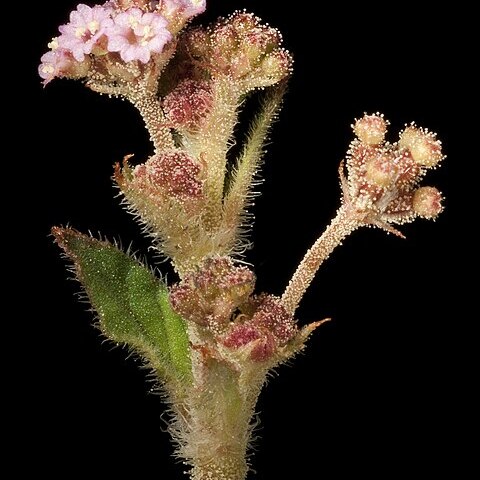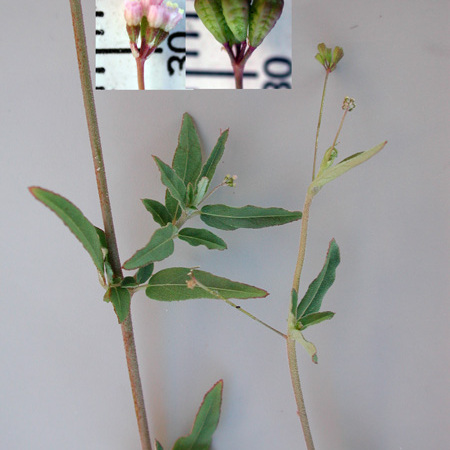Herbs, annual or perennial, sometimes suffrutescent at base, slender, often glandular, glabrous, or pubescent, from slender and soft or stout, ± woody, and ropelike or fusiform taproot. Stems procumbent, decumbent, ascending, or erect, unarmed, with or without glutinous bands on internodes. Leaves petiolate, pairs unequal in size in each pair; blade thin or thick and slightly fleshy, base symmetric to asymmetric. Inflorescences terminal and axillary, pedunculate or not clearly pedunculate because of repeated branching from distal axils, diffuse, and then usually widely cymose, paniculate, or thyrsiform, terminal portions cymose, racemose, spicate, subumbellate, umbellate, subcapitate, or capitate, rarely borne singly; bracts ± persistent and not accrescent, or deciduous, 1-3 beneath each flower, distinct, lanceolate, minute, thin, translucent. Flowers bisexual, chasmogamous; perianth radially symmetric or slightly bilaterally symmetric, campanulate or widely funnelform, constricted beyond ovaries, tube abruptly expanded to (4-)5-lobed limb; stamens 2-8, included or exserted; styles at or extending beyond anthers; stigmas peltate. Fruits fusiform, clavate, oblong-clavate, obovoid, or obpyramidal, stiffly coriaceous; ribs (3-)5, rounded, angular, or winglike, smooth, glabrous or glandular-pubescent; sulci smooth or rugose, epidermal surface smooth, papillate, or minutely pubescent.
Annual herbs, erect, ascending or creeping, puberulous-glabrescent, with sessile or stalked, club-shaped glands or hairs; stem base and root often woody. Stems often red tinged and swollen (when dry constricted) at the nodes. Leaves opposite, subequal in each pair, beneath paler, the epidermis with minute irregular cystolith-like sculpture, and sometimes with embedded reddish glands. Inflorescences axillary, in the axil of the smallest leaf of each pair, or (B. erecta) by reduction of leaves into bracts each stem forming one large thyrsoid inflorescence appearing terminal at the extremities, subumbels of 2-10 small flowers. Bracts (basal) and bracteoles (apical) small, acute, fimbriate, caducous. Pedicels jointed with the flower, mostly very short. Flowers bisexual. Perianth tubular-campanulate, with a distinct constriction mostly halfway; lower part (later becoming the coriaceous anthocarp) obconical, 5-or 10-ribbed, upper caducous part 5-lobed, plicate in bud, white or pink. Stamens 1-4, exserted. Ovary (sub)sessile, smooth; style as long as the perianth; stigma capitate. Anthocarp closed at apex, 5-10-ribbed, glabrous or set with glands, swelling and slimy in water. Seed with longitudinally folded embryo; cotyledons with recurved margin and surrounding the mealy endosperm.
Annual or perennial herbs, erect, diffuse or decumbent, sometimes with woody base; roots commonly thick, fleshy or woody; stems usually branched, terete, glabrous or hairy; hairs glandular, often glandular-viscid; raphides commonly present in all structures. Leaves opposite, those at each node often of unequal size, sinuate or entire, often undulate, often fleshy, usually grading to bracts above. Inflorescences usually grading along branches from simple to compound; basic inflorescence unit a solitary flower, a glomerule, or an umbel; bracteoles minute, membranous. Flowers small, bisexual. Perianth tubular, the upper part caducous, 5-lobed, campanulate or trumpet-shaped, white, pink, mauve or crimson-purple. Stamens 1–4, rarely to 6; anthers suborbicular, included or shortly exserted. Style slender, often elongate; stigma capitate. Fruit indehiscent, conspicuously 3–5-sulcate, with blunt, acute or winged ribs, often densely glandular-viscid; ribs usually mucous when wet. Seed 1, erect. See also Du Puy & Telford (1993: 104), Green (1994: 75).
Herbs annual or perennial, erect, ascending, or procumbent. Stems sometimes glandular. Leaves opposite, often unequal, petiolate, margin entire or sinuate. Inflorescences usually terminal, sometimes apparently axillary, of small umbels, often irregular, rarely 1-flowered, grouped into cymose panicles. Flowers bisexual, small; bracteoles minute, often deciduous. Perianth constricted beyond the ovary, limb campanulate, apex 5-lobed, truncate, or plicate, caducous, Stamens 1-5, included or shortly exserted; filaments connate at base. Ovary oblique, stipitate. Stigma peltate or capitate. Fruit obovoid, turbinate, clavate, or terete, small, 5-ribbed or deeply 5-angled, often rough, with sessile, sticky glands. Seed: embryo curved, cotyledons thin, broad, enclosing the thin endosperm.
Annual or perennial herbs. Leaves opposite or subopposite, petiolate, frequently unequal at the nodes, the blade undulate or sinuate, conspicuously raphidulous. Inflorescence terminal, paniculiform to racemiform, many-flowered. Flowers small, perfect, subtended by 1-3 minute bracteoles, the perianth tube persistent, more or less herbaceous, frequently glandular, the perianth limb deciduous, petalaceous, obscurely 5-lobed; stamens 1-5, included or exserted; ovary shortly stipitate, the stigma capitate, more or less exserted. Anthocarp obpyramidal to obovoid or subellipsoid, glabrous to glandular, 3-to 5-angulate.


